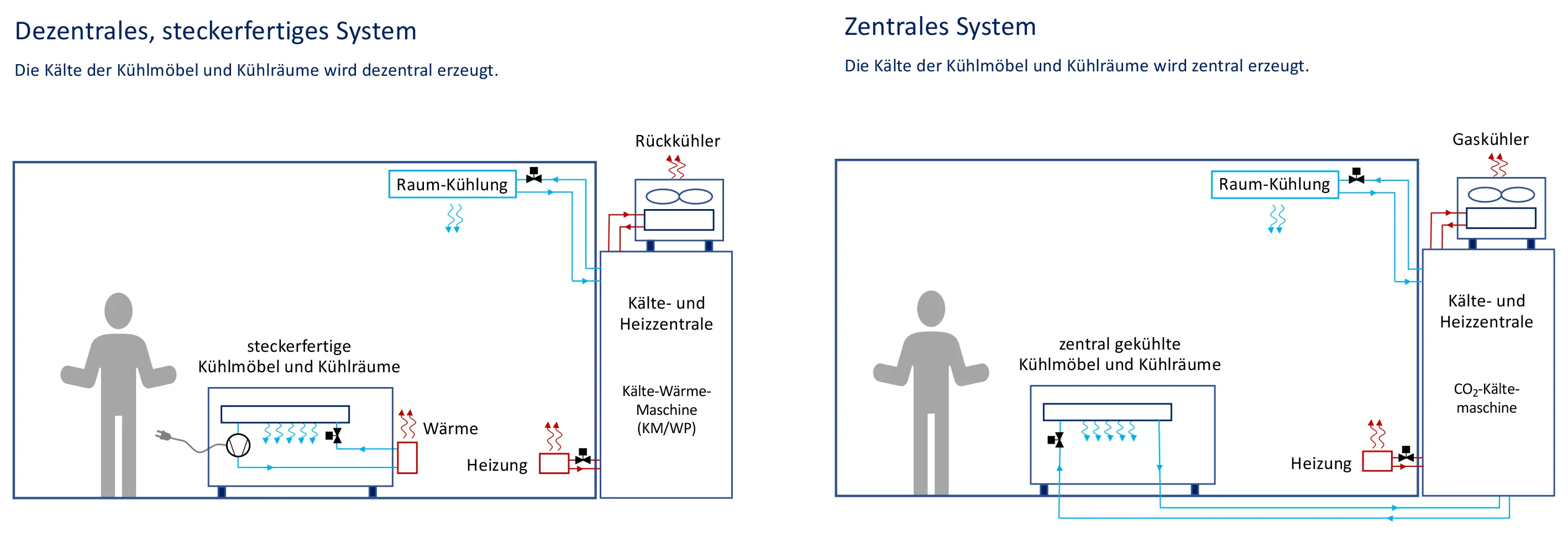Are decentralised or centralised cooling systems in supermarkets more efficient?
The Institute of Energy Systems and Fluid Engineering (IEFE) at the ZHAW has simulated and compared supermarkets with different cooling systems. The aim of the researchers was an energy and economic comparison, taking into account the entire supermarket operation and various climatic conditions. The study shows that supermarkets with plug-in refrigeration units have the highest electricity consumption due to their high air conditioning requirements. A centralised refrigeration supply is the most efficient. It works with high efficiency and can utilise the heat generated. The researchers also found that the energy label is unsuitable for comparing plug-in and centrally cooled refrigerated cabinets.

Which is better in energy terms - a supermarket with decentralised (plug-in) or centrally cooled refrigerated cabinets and cold rooms? On behalf of the Swiss Federal Office of Energy (SFOE) and the Swiss Association for Refrigeration Technology (SVK), the Institute of Energy Systems and Fluid Engineering IEFE at the ZHAW has comprehensively compared the different refrigeration systems for supermarkets in terms of energy efficiency and cost-effectiveness.
The study simulated the entire supermarket operation with the various heat inputs (heat from ovens, lighting, people) and the energy requirements for cooling and heating over the course of a year. In order to visualise the climatic dependencies, the simulation was carried out for the three Swiss locations of Zurich, Lugano and Davos. In addition, two different store areas (340 m2 and 1250 m2) were considered. The following three cooling systems were compared with each other:
Decentralised, plug-in systems
With plug-in refrigerated cabinets and cold rooms, the cold is generated decentral in the refrigerated cabinet or cold room and the heat is released directly into the room. If it gets too warm in the shop, the heat is cooled with a cooling/heating machine ("air conditioning operation"). The heat is dissipated via the recooler and can be used for heating if required (in winter). One advantage of the plug-in systems is their flexibility - operators can simply move the refrigerated cabinets around.
Hybrid, plug-in systems
In hybrid, plug-in refrigerated cabinets and cold rooms, cooling is generated decentral. If required, the heat is either used to heat the shop directly or is dissipated via a secondary circuit. If it still gets too warm in the shop, a cooling/heating machine ("air conditioning operation") cools the rooms and the heat is dissipated via the recooler. If heating is required in the shop in winter, the cooling/heating machine ("heat pump mode") is used.
Centralised systems
The refrigerated cabinets and cold rooms are cooled with a central CO2 refrigeration machine and the heat is dissipated via a gascooler. At the same time, the CO2 chiller can cool the shop. If there is a need for heating, the heat from the CO2 chiller can be utilised for heating. One advantage of centralised systems is that the refrigerated cabinets do not need a compressor and therefore have more space for the products.
The centralised refrigeration supply is ahead
The researchers' findings show that supermarkets with conventional, plug-in refrigeration units (decentralised solution) have the highest electricity consumption. One reason for this is the high air conditioning requirement in the warmer months of the year. Hybrid plug-in refrigeration systems are significantly more efficient, as the heat is released into the outside air and only enters the supermarket when required. The most efficient cooling systems, on the other hand, are refrigerated cabinets and cold rooms that are supplied by a centralised system. Here, refrigeration is significantly more efficient than with plug-in refrigeration units. In addition, the heat from the refrigeration machine can also be utilised (with a CO2 booster refrigeration machine).
The energy label is not suitable for comparing different systems
The analysis shows: The energy label is suitable for comparing two identical refrigeration unit models. However, the energy label is not suitable for a system comparison between plug-in refrigerated cabinets and centrally cooled refrigerated cabinets. According to the test standards, plug-in refrigeration units generally receive a bonus of 10 per cent for their energy efficiency index (EEI), whereas centrally cooled refrigeration units do not. Furthermore, the refrigerated cabinets are tested under fixed ambient conditions without taking seasonal differences into account. In particular, centralised and hybrid plug-in cooling systems, which are dependent on the ambient temperature, are therefore rated worse than they actually are in practice. In addition, the energy label only considers the refrigeration unit. The energy required by the air conditioning system to cool the heat emitted by the plug-in refrigeration unit is not taken into account.
And the costs?
The calculations in the study show that the investment costs for centrally cooled systems are slightly higher than for systems with plug-in appliances. However, over the entire service life, the costs for the different systems in the supermarket with an area of 340 m2 are roughly the same. In a supermarket with an area of 1,250 m2, the costs for centrally cooled systems are even significantly lower. From the point of view of energy consumption and cost-effectiveness, it is therefore always worth taking a close look at the systems.
Project name: Energetischer Vergleich von steckerfertigen und zentralgekühlten Kühlsystemen im Supermarkt
Participants:
Project manager: Manuel Diem
Project team: Christian Stahel, Silvan Steiger, Mirco Ganz, Frank Tillenkamp
Funded by: Swiss Federal Office of Energy (SFOE), Swiss Refrigeration Association (SVK)
Project partners: Sandro Stefanutti, Leplan AG, Thomas Lang zweiweg GmbH
Project duration: November 2022 to May 2024
Publications:
Final report: https://dropnet.amkplus.ch/svk_homepage/Schlussbericht_Vergleich_Supermarktkuehlsysteme.pdf